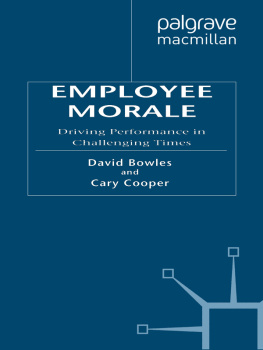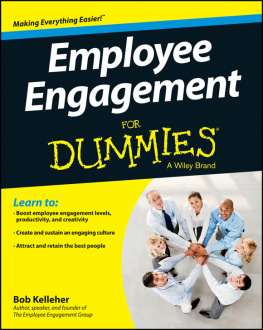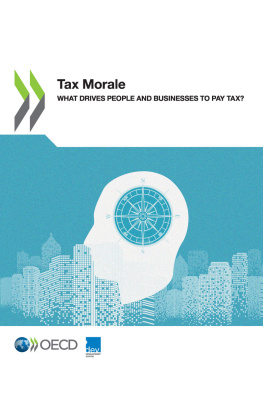EMPLOYEE MORALE
EMPLOYEE MORALE
Driving Performance in Challenging Times
David Bowles
Managing Director, Research & Consulting International, Rancho Santa Fe, California
and
Cary Cooper
Pro Vice Chancellor (External Relations)
and
Professor of Organizational Psychology and Health, Lancaster University


David Bowles & Cary Cooper 2009
All rights reserved. No reproduction, copy or transmission of this publication may be made without written permission.
No portion of this publication may be reproduced, copied or transmitted save with written permission or in accordance with the provisions of the Copyright, Designs and Patents Act 1988, or under the terms of any licence permitting limited copying issued by the Copyright Licensing Agency, Saffron House, 6-10 Kirby Street, London EC1N 8TS.
Any person who does any unauthorized act in relation to this publication may be liable to criminal prosecution and civil claims for damages.
The authors have asserted their rights to be identified as the authors of this work in accordance with the Copyright, Designs and Patents Act 1988.
First published 2009 by
PALGRAVE MACMILLAN
Palgrave Macmillan in the UK is an imprint of Macmillan Publishers Limited, registered in England, company number 785998, of Houndmills, Basingstoke, Hampshire RG21 6XS.
Palgrave Macmillan in the US is a division of St Martins Press LLC, 175 Fifth Avenue, New York, NY 10010.
Palgrave Macmillan is the global academic imprint of the above companies and has companies and representatives throughout the world.
Palgrave and Macmillan are registered trademarks in the United States, the United Kingdom, Europe and other countries.
ISBN-13: 978-0-230-57942-2
This book is printed on paper suitable for recycling and made from fully managed and sustained forest sources. Logging, pulping and manufacturing processes are expected to conform to the environmental regulations of the country of origin.
A catalogue record of the book is available from the British Library.
A catalog record for this book is available from the Library of Congress.
10 9 8 7 6 5 4 3 2 1
18 17 16 15 14 13 12 11 10 09
Printed and bound in Great Britain by
CPI Antony Rowe, Chippenham and Eastbourne
LIST OF FIGURES, TABLES AND CHARTS
Figures
1 Model of morale
2 Scoring for a simple ranking system
3 Hiltis positive flow: From management to employees and customers
Tables
1 Summary: Methods of gathering morale information
2 Scoring for a more complex ranking system
3 Sirota analysis of morale relationship to financial performance, 20045
4 Accenture performance factors
5 Accenture Most Important functions
6 Mercer table of engagement factors by country
Charts
1 Morale index by group, typical company data: Above average performers
2 Morale index by group, typical company data: average performance
3 Morale index by group, typical company data: Below average performers
4 Ratio of engaged to disengaged employees among top quartile EPS and bottom two quartiles (below average) EPS of Gallup employee engagement database
5 Comparison of top quartile (employee engagement) and bottom two quartiles (employee engagement) groups by EPS growth, 200103 and 200405
6 Hilti morale and unit size
7 Hilti morale and supervisor seen as encouraging employee suggestions
8 Hilti morale and local management ability
9 Morale of different employee groups and % of Hilti Fans/Bonded Customers
10 Effect of time on morale-customer satisfaction correlation: Hilti Fans
11 Mercer database of engagement by country, percent favorable
12 The middle years
ACKNOWLEDGMENTS
DAVID BOWLES
My first acknowledgment and dedication belongs to my beloved Janice, without whom this book would not have been possible; I also dedicate the book to my wonderful mother, sisters and extended family in England; to my friends at Starbucks Del Mar Heights who cajoled, encouraged, criticized and contributed ideas to make the book better. Many thanks go out to the employees at Starbucks Torrey Hills, who kept me in coffee and support while most of the book was written, and to authors before me who demonstrated convincingly that large parts of a book could indeed be written in a Caf! One of those Starbucks employees, Ryan Shue, deserves special thanks for sitting down for a long interview on military morale and his experiences in that area as a US Marine. Professor Mika Kivimki of UCL, London, was a great help in understanding some of the issues related to her extensive and thorough research on morale and employee health. Thanks too for the use of the University of California, San Diego, Geisel library facilities, open almost around the clock and so comfortable and comprehensive, which allowed me to research this book and write large sections of it.
Our support at Palgrave Macmillan has been 110 percent and I am especially grateful to Stephen Rutt for agreeing almost instantly to our proposal for a book linking morale and performance, to Eleanor Davey-Corrigan for making it all run so smoothly, and to Macmillan Publishing Solutions in Bangalore for their speedy and excellent copy editing.
Several companies have contributed their help and shared part of their intellectual property with us in order to bring you the best morale research that there is. Many thanks go out to Hilti Group in Liechtenstein, and its Chairman, Dr Pius Baschera, for agreeing to share their data and be our Case Study. Hilti lives what we talk about in this book. Thanks also to Klaus Risch, current Executive VP and Global head of HR at Hilti; also to Andre Siegenthaler, formerly in that job at Hilti, who was such a great client and friend while the Hilti data were being collected a few years back.
We both very much appreciate the following organizations for giving us access to their data:
The Gallup Organization; Mercer; Accenture; Sirota Survey Intelligence; American Society for Quality; American Marketing Association; Rowman & Littlefield Publishing Group; American Psychological Association; MIT-Sloan Management Review; Taylor and Francis (Productivity Press); BAI Banking Intelligence.
Finally, I would like to make a special dedication to two dear friends: my former consulting partner Dr Marshall Whitmire, who worked tirelessly to see that our small research and consulting firm kept clients happy around the world; and my friend and colleague of almost 40 years, Cary Cooper, who has taught, inspired, encouraged and believed in me for all that time. It is an honor to write a book with him.
CARY COOPER
I learned a great deal about morale and camaraderie from all my former Ph.D. students, who supported and valued me throughout my career this book is dedicated to them.
INTRODUCTION
Being in the morale business, we experience something like doctors who go to cocktail parties and accidentally let the fact of their profession slip out, resulting in all sorts of symptoms being shared, and diagnoses requested. Mention work morale to a perfect stranger and they respond with a knowing laugh, a groan and always, always the same comment: You should come to my work place!! Are they asking us to come because things are so great? Not judging by the comments which follow their invitation, no. Details of the boss from hell, the colleague from hell or the company from hell follow. Of course, when asked how long they have been there, and hearing fifteen years, the question begs to be asked then why stay so long? The answer is usually quick, sure-footed, something like I love the people there (except for the boss or colleague from hell, of course), I love the job, great benefits and so on. This is the essence of the complex of human emotions and related opinions we call morale, the mix of positive and negative, this feeling we have at and about our work, where we spend so much of our waking time. As much as we complain, too, lets remember that when a person takes him or herself out of the workforce through retirement or other reasons, the result is often painful for that individual, sometimes even fatal. Is it just a coincidence that, even after a days work in environments of varying sustenance, as far as morale is concerned, many of us sit down to watch










